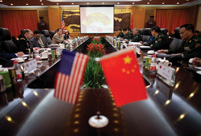 'Jin' named the word of the year by cross-strait netizens
'Jin' named the word of the year by cross-strait netizens Chinese scientific expedition goes to build new Antarctica station
Chinese scientific expedition goes to build new Antarctica station
 Chinese naval escort fleet conducts replenishment in Indian Ocean
Chinese naval escort fleet conducts replenishment in Indian Ocean 17th joint patrol of Mekong River to start
17th joint patrol of Mekong River to start China's moon rover, lander photograph each other
China's moon rover, lander photograph each other Teaming up against polluters
Teaming up against polluters
BEIJING, Jan. 2 -- China has produced a miracle in being able to feed 22 percent of the global population using only 7 percent of the world's farmland, and it is now ready to push forward a new round of agricultural reforms.
A central rural work conference in December set out a series of reform measures aimed at protecting farmland and farmers' rights, and building a safety net for agricultural financing.
China's huge population means the task of simply feeding the people remains a high priority. China must rely on itself and pursue a national food security strategy of maintaining agricultural productivity, importing moderately, and employing science and technology, a statement after the conference said.
China has set a firm baseline that arable land never shrinks to less than 1.8 billion mu (120 million hectares). The line should be strictly met, the statement stressed.
China's strong protection for arable land and promotion of efficient subsidies were strategic moves suitable for a populous country and conducive to global food safety, Choi Pil Soo, associate research fellow at Korea Institute for International Economic Policy, said.
Choi said China's policy orientation would help it avoid South Korea's mistakes in the early 1950s: the failure to protect arable land that weakened its agricultural foundation and generated a heavy reliance on imported agricultural products.
While sticking to collective land ownership, the Chinese government has decided to allow farmers to transfer or mortgage their contracted land, or turn the rights into shares in large-scale farming entities.
Farmers are encouraged to "franchise" their lands to large farming entities, including farms, farmers' cooperatives and agricultural enterprises. No matter how the usage right is transferred, the farmers will remain the legal "owners", or contractors of their lands, according to the rural work conference.
Guo Shengxiang, a renowned Australian economist, said the new policy offered strong support for farmers' land rights and would server as a basis for the legal mortgaging of contracted land, which would boost farmers' property income and facilitate finance for agriculture.
The government also proposed at the conference to make farmers richer and better educated, to make being a farmer more profitable and attractive as a profession, and to make country areas desirable places to live and work.
Guo said the proposal sent a clear message that China's rural issues needed to be addressed by lifting farmers' social and economic status. Following the example of developed countries, farmers can live and work comfortably and agriculture develop steadily only by making farmers professionals, safeguarding their income and social security, facilitating community services and modernizing the sector.
On the subject of agricultural financing, it was also stated at the conference that China would increase investment and establish a finance system that suited agricultural and rural characteristics.
Ruan Wei, chief researcher at Japan's Norinchukin Research Institute, said China needed to build a long-term, low-interest agricultural finance system and an insurance mechanism for agriculture disasters.
Considering the large input, high risk and long cycle of agricultural production, authorities should provide long-term policy financing. In the case of Japan, such loans could last 15 to 20 years, Ruan said.
Fan Shenggen, director general of the International Food Policy Research Institute, said creative measures should be introduced in building an insurance mechanism for agriculture disasters, and collective insurance could help lower the cost.
 Commemorate 120th birth anniversary of Mao Zedong
Commemorate 120th birth anniversary of Mao Zedong Female soldiers of PLA Marine Corps in training
Female soldiers of PLA Marine Corps in training Chinese cities to have a very grey Christmas as smog persists
Chinese cities to have a very grey Christmas as smog persists China and U.S. - the national image in each other’s eyes
China and U.S. - the national image in each other’s eyes The Liaoning's combat capability tested in sea trial
The Liaoning's combat capability tested in sea trial Chinese pole dancing team show their moves in snow
Chinese pole dancing team show their moves in snow Rime scenery in Mount Huangshan
Rime scenery in Mount Huangshan Ronnie O'Sullivan: My children mean the world to me
Ronnie O'Sullivan: My children mean the world to me Shopping in Hong Kong: a different picture
Shopping in Hong Kong: a different picture Yearender: Animals' life in 2013
Yearender: Animals' life in 2013 Hello 2014 - Chinese greet the New Year
Hello 2014 - Chinese greet the New Year Chocolate 'Terracotta Warriors' appear
Chocolate 'Terracotta Warriors' appear  Top 10 domestic news of 2013
Top 10 domestic news of 2013 Red crabs begin annual migrations in Australia
Red crabs begin annual migrations in Australia Artifacts retrieved from West Zhou Dynasty
Artifacts retrieved from West Zhou DynastyDay|Week|Month